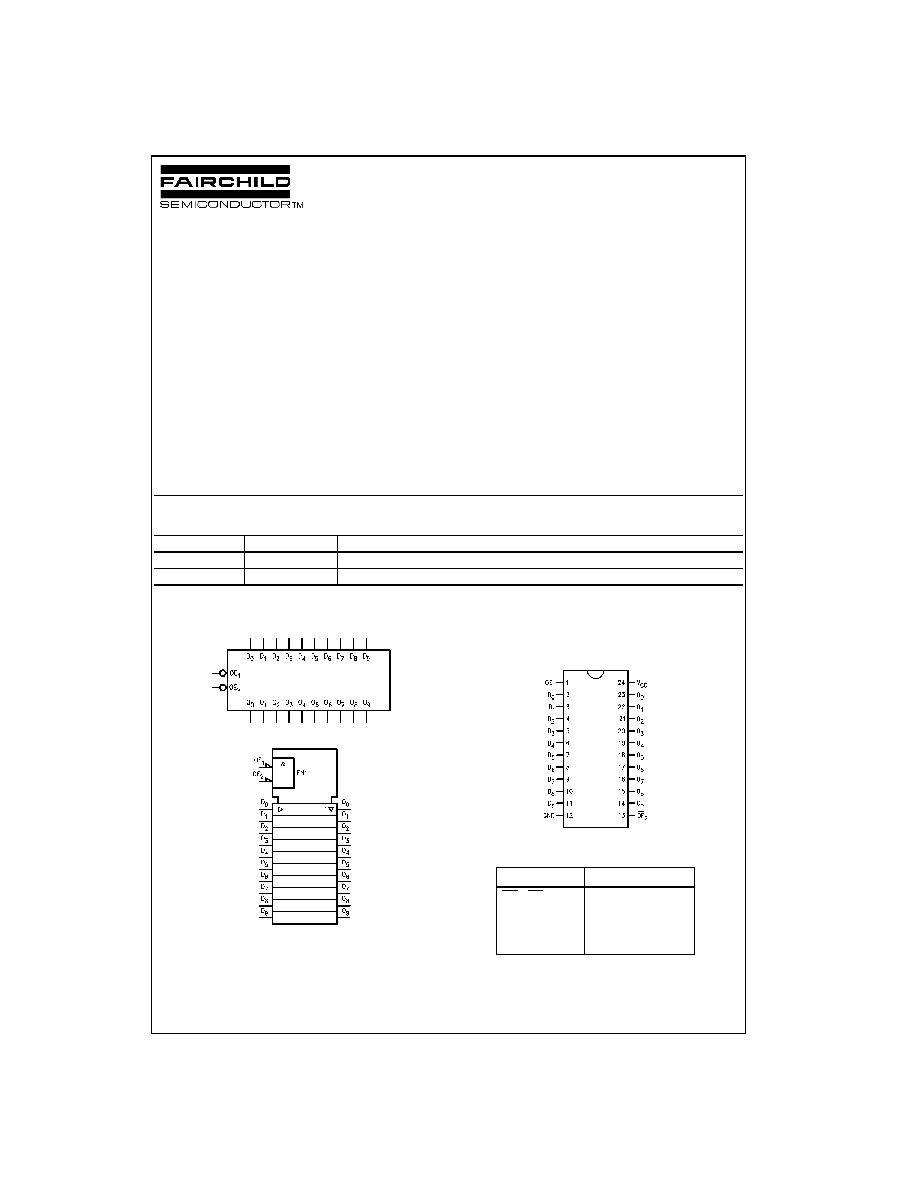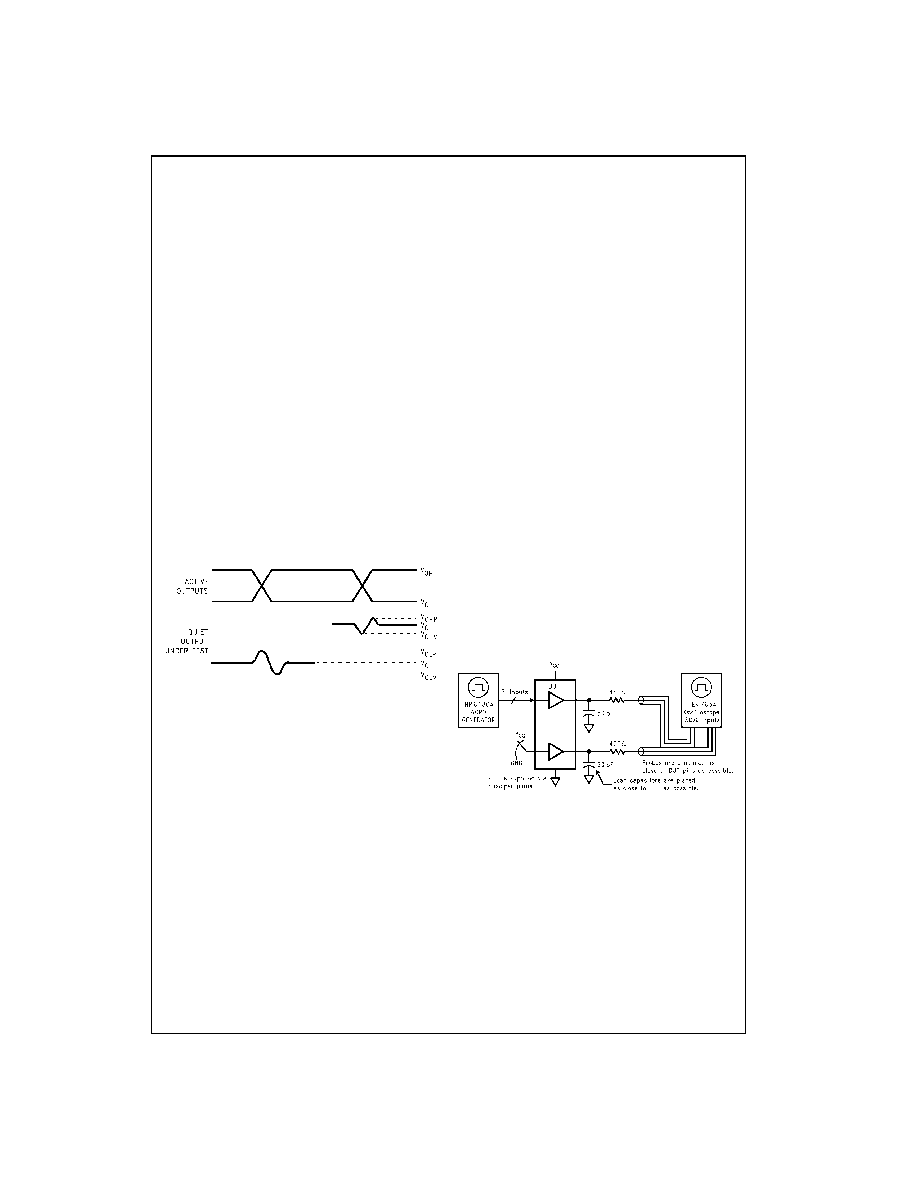
March 1990
Revised December 1998
7
4
A
C
TQ827 Quiet
Ser
i
es
TM
10-
Bit
Buf
f
e
r
/
Li
ne
Dr
iver
wi
th 3-ST
A
T
E
Out
puts
© 1999 Fairchild Semiconductor Corporation
DS010687.prf
www.fairchildsemi.com
74ACTQ827
Quiet Series
TM
10-Bit Buffer/Line Driver
with 3-STATE Outputs
General Description
The ACTQ827 10-bit bus buffer provides high performance
bus interface buffering for wide data/address paths or
buses carrying parity. The 10-bit buffers have NOR output
enables for maximum control flexibility. The ACTQ827 uti-
lizes Fairchild Quiet Series
TM
technology to guarantee quiet
output switching and improved dynamic threshold perfor-
mance. FACT Quiet Series
TM
features GTO
TM
output control
and undershoot corrector in addition to a split ground bus
for superior performance.
Features
s
Guaranteed simultaneous switching noise level and
dynamic threshold performance
s
Guaranteed pin-to-pin skew AC performance
s
Inputs and outputs on opposite sides of package allow
easy interface with microprocessors
s
Improved latch-up immunity
s
Outputs source/sink 24 mA
s
Functionally and pin-compatible to AMD's AM29827
s
Has TTL-compatible inputs
Ordering Code:
Device also available in Tape and Reel. Specify by appending suffix letter "X" to the ordering code.
Logic Symbols
IEEE/IEC
Connection Diagram
Pin Assignment
for DIP and SOIC
Pin Descriptions
FACT
TM
, Quiet Series
TM
, FACT Quiet Series
TM
and GTO
TM
are trademarks of Fairchild Semiconductor Corporation.
Order Number
Package Number
Package Description
74ACTQ827SC
M24B
24-Lead Small Outline Integrated Circuit (SOIC), JEDEC MS-013, 0.300" Wide Body
74ACTQ827SPC
N24C
24-Lead Plastic Dual-In-Line Package (PDIP), JEDEC MS-100, 0.300" Wide
Pin Names
Description
OE
1
, OE
2
Output Enable
D
0
≠D
9
Data Inputs
O
0
≠O
9
Data Outputs

3
www.fairchildsemi.com
7
4
A
C
TQ827
Absolute Maximum Ratings
(Note 1)
Recommended Operating
Conditions
Note 1: Absolute maximum ratings are those values beyond which damage
to the device may occur. The databook specifications should be met, with-
out exception, to ensure that the system design is reliable over its power
supply, temperature, and output/input loading variables. Fairchild does not
recommend operation of FACT
TM
circuits outside databook specifications.
DC Electrical Characteristic
Supply Voltage (V
CC
)
-
0.5V to
+
7.0V
DC Input Diode Current (I
IK
)
V
I
=
-
0.5V
-
20 mA
V
I
=
V
CC
+
0.5V
+
20 mA
DC Input Voltage (V
I
)
-
0.5V to V
CC
+
0.5V
DC Output Diode Current (I
OK
)
V
O
=
-
0.5V
-
20 mA
V
O
=
V
CC
+
0.5V
+
20 mA
DC Output Voltage (V
O
)
-
0.5V to V
CC
+
0.5V
DC Output Source
or Sink Current (I
O
)
±
50 mA
DC V
CC
or Ground Current
per Output Pin (I
CC
or I
GND
)
±
50 mA
Storage Temperature (T
STG
)
-
65
∞
C to
+
150
∞
C
DC Latch-Up Source
or Sink Current
±
300 mA
Junction Temperature (T
J
)
PDIP
140
∞
C
Supply Voltage (V
CC
)
4.5V to 5.5V
Input Voltage (V
I
)
0V to V
CC
Output Voltage (V
O
)
0V to V
CC
Operating Temperature (T
A
)
-
40
∞
C to
+
85
∞
C
Minimum Input Edge Rate
V/
t
125 mV/ns
V
IN
from 0.8V to 2.0V
V
CC
@ 4.5V, 5.5V
Symbol
Parameter
V
CC
T
A
=
+
25
∞
C
T
A
=
-
40
∞
C to
+
85
∞
C
Units
Conditions
(V)
Typ
Guaranteed Limits
V
IH
Minimum HIGH Level
4.5
1.5
2.0
2.0
V
V
OUT
=
0.1V
Input Voltage
5.5
1.5
2.0
2.0
or V
CC
-
0.1V
V
IL
Maximum LOW Level
4.5
1.5
0.8
0.8
V
V
OUT
=
0.1V
Input Voltage
5.5
1.5
0.8
0.8
or V
CC
-
0.1V
V
OH
Minimum HIGH Level
4.5
4.49
4.4
4.4
V
I
OUT
=
-
50
µ
A
Output Voltage
5.5
5.49
5.4
5.4
V
IN
=
V
IL
or V
IH
4.5
3.86
3.76
V
I
OH
=
-
24 mA
5.5
4.86
4.76
I
OH
=
-
24 mA (Note 2)
V
OL
Maximum LOW Level
4.5
0.001
0.1
0.1
V
I
OUT
=
50
µ
A
Output Voltage
5.5
0.001
0.1
0.1
V
IN
=
V
IL
or V
IH
4.5
0.36
0.44
V
I
OL
=
24 mA
5.5
0.36
0.44
I
OL
=
24 mA (Note 2)
I
IN
Maximum Input
5.5
±
0.1
±
1.0
µ
A
V
I
=
V
CC
, GND
Leakage Current
I
OZ
Maximum 3-STATE
5.5
±
0.5
±
5.0
µ
A
V
I
=
V
IL
, V
IH
Current
V
O
=
V
CC
, GND
I
CCT
Maximum I
CC
/Input
5.5
0.6
1.5
mA
V
I
=
V
CC
-
2.1V
I
OLD
Minimum Dynamic
5.5
75
mA
V
OLD
=
1.65V Max
I
OHD
Output Current (Note 3)
5.5
-
75
mA
V
OHD
=
3.85V Min
I
CC
Maximum Quiescent
5.5
8.0
80.0
µ
A
V
IN
=
V
CC
Supply Current
or GND
V
OLP
Quiet Output
5.0
1.1
1.6V
V
Figure 1, Figure 2
Maximum Dynamic V
OL
(Note 4)(Note 5)
V
OLV
Quiet Output
5.0
-
0.6
-
1.3
V
Figure 1, Figure 2
Minimum Dynamic V
OL
(Note 4)(Note 5)
V
IHD
Minimum HIGH Level
5.0
1.9
2.0
V
(Note 4)(Note 6)
Dynamic Input Voltage
V
ILD
Maximum LOW Level
5.0
1.2
0.8
V
(Note 4)(Note 6)
Dynamic Input Voltage

www.fairchildsemi.com
4
74A
C
T
Q
827
DC Electrical Characteristic
(Continued)
Note 2: All outputs loaded; thresholds on input associated with output under test.
Note 3: Maximum test duration 2.0 ms, one output loaded at a time.
Note 4: DIP package.
Note 5: Max number of outputs defined as (n). Data inputs are driven 0V to 3V. One output @ GND.
Note 6: Max number of data inputs (n
-
1) inputs switching 0V to 3V (ACTQ). Input-under-test switching:
3V to threshold (V
ILD
), 0V to threshold. (V
IHD
), f
=
1 MHz.
AC Electrical Characteristics
Note 7: Voltage Range 5.0 is 5.0V
±
0.5V.
Note 8: Skew is defined as the absolute value of the difference between the actual propagation delay for any two outputs within the same packaged device.
The specification applies to any outputs switching in the same direction, either HIGH to LOW (t
OSHL
) or LOW to HIGH (t
OSLH
). Parameter guaranteed by
design. Not tested.
Capacitance
V
CC
T
A
=
+
25
∞
C
T
A
=
-
40
∞
C to
+
85
∞
C
Symbol
Parameter
(V)
C
L
=
50 pF
C
L
=
50 pF
Units
(Note 7)
Min
Typ
Max
Min
Max
t
PHL
Propagation Delay
5.0
2.5
5.6
8.0
2.5
9.0
ns
t
PLH
Data to Output
t
PZL
t
PZH
Output Enable Time
5.0
3.0
7.1
10.0
3.0
11.0
ns
t
PHZ
t
PLZ
Output Disable Time
5.0
1.0
5.8
8.0
1.0
8.5
ns
t
OSHL
Output to Output
5.0
0.5
1.5
1.5
ns
t
OSLH
Skew (Note 8)
Data to Output
Symbol
Parameter
Typ
Units
Conditions
C
IN
Input Capacitance
4.5
pF
V
CC
=
OPEN
C
PD
Power Dissipation Capacitance
82
pF
V
CC
=
5.0V

5
www.fairchildsemi.com
7
4
A
C
TQ827
FACT Noise Characteristics
The setup of a noise characteristics measurement is critical
to the accuracy and repeatability of the tests. The following
is a brief description of the setup used to measure the
noise characteristics of FACT.
Equipment:
Hewlett Packard Model 8180A Word Generator
PC-163A Test Fixture
Tektronics Model 7854 Oscilloscope
Procedure:
1. Verify Test Fixture Loading: Standard Load 50 pF,
500
.
2. Deskew the HFS generator so that no two channels
have greater than 150 ps skew between them. This
requires that the oscilloscope be deskewed first. It is
important to deskew the HFS generator channels
before testing. This will ensure that the outputs switch
simultaneously.
3. Terminate all inputs and outputs to ensure proper load-
ing of the outputs and that the input levels are at the
correct voltage.
4. Set the HFS generator to toggle all but one output at a
frequency of 1 MHz. Greater frequencies will increase
DUT heating and effect the results of the measure-
ment.
5. Set the word generator input levels at 0V LOW and 3V
HIGH for ACT devices and 0V LOW and 5V HIGH for
AC devices. Verify levels with an oscilloscope.
Note 9: V
OHV
and V
OLP
are measured with respect to ground reference.
Note 10: Input pulses have the following characteristics: f
=
1 MHz,
t
r
=
3 ns, t
f
=
3 ns, skew
<
150 ps.
FIGURE 1. Quiet Output Noise Voltage Waveforms
V
OLP
/V
OLV
and V
OHP
/V
OHV
:
∑ Determine the quiet output pin that demonstrates the
greatest noise levels. The worst case pin will usually be
the furthest from the ground pin. Monitor the output volt-
ages using a 50
coaxial cable plugged into a standard
SMB type connector on the test fixture. Do not use an
active FET probe.
∑ Measure V
OLP
and V
OLV
on the quiet output during the
worst case transition for active and enable. Measure
V
OHP
and V
OHV
on the quiet output during the worst
case active and enable transition.
∑ Verify that the GND reference recorded on the oscillo-
scope has not drifted to ensure the accuracy and repeat-
ability of the measurements.
V
ILD
and V
IHD
:
∑ Monitor one of the switching outputs using a 50
coaxial
cable plugged into a standard SMB type connector on
the test fixture. Do not use an active FET probe.
∑ First increase the input LOW voltage level, V
IL
, until the
output begins to oscillate or steps out a min of 2 ns.
Oscillation is defined as noise on the output LOW level
that exceeds V
IL
limits, or on output HIGH levels that
exceed V
IH
limits. The input LOW voltage level at which
oscillation occurs is defined as V
ILD
.
∑ Next decrease the input HIGH voltage level, V
IH
, until
the output begins to oscillate or steps out a min of 2 ns.
Oscillation is defined as noise on the output LOW level
that exceeds V
IL
limits, or on output HIGH levels that
exceed V
IH
limits. The input HIGH voltage level at which
oscillation occurs is defined as V
IHD
.
∑ Verify that the GND reference recorded on the oscillo-
scope has not drifted to ensure the accuracy and repeat-
ability of the measurements.
FIGURE 2. Simultaneous Switching Test Circuit




